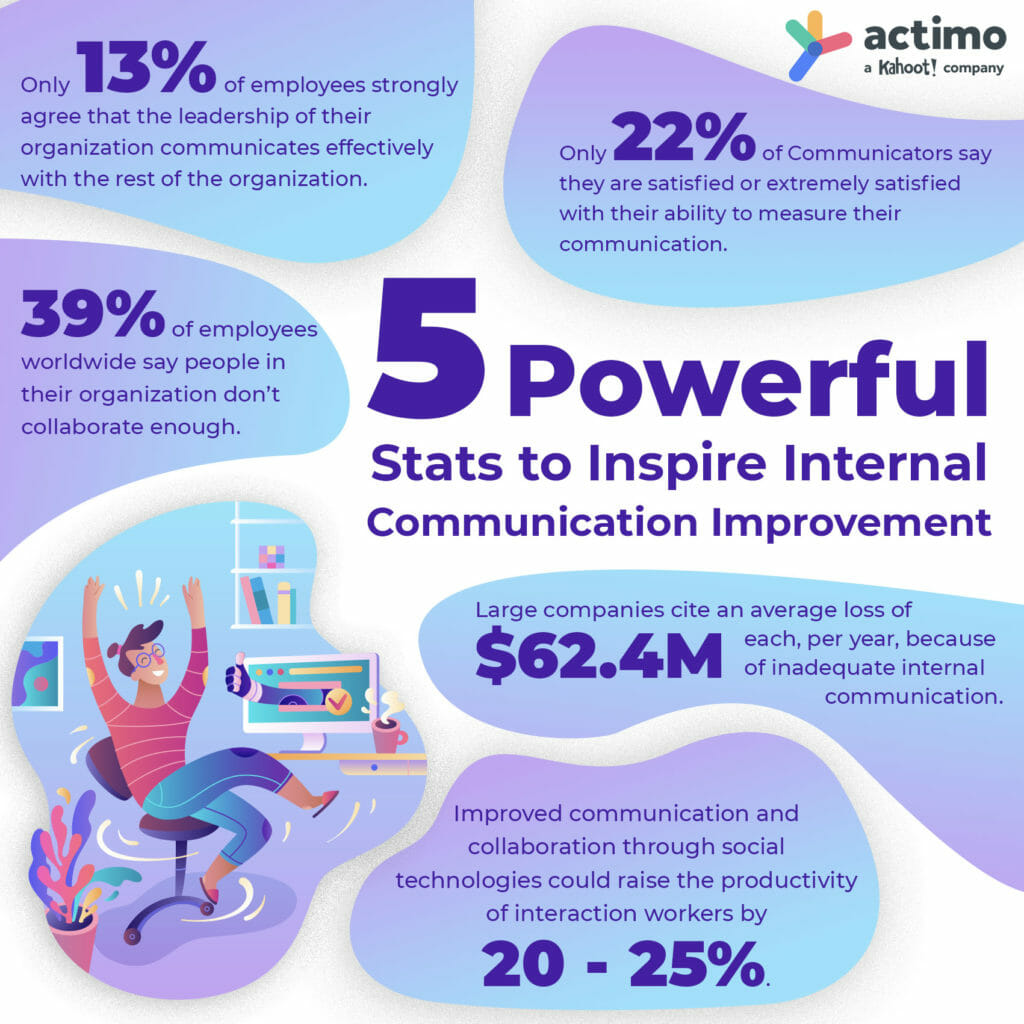In an ideal world, everyone would recognize the importance of effective internal communication in business. Good thing you are here, wanting to be more aware of it! We’ve gathered shocking statistics to spark positive change or the desire to improve internal communication across your organization.
Scroll to the end for key takeaways from these.
Now, check out 5 powerful internal communication stats every leader needs to hear and feel inspired by:

1) Only 13% of employees strongly agree that leadership at their organization communicates effectively with the rest of the organization.
That means about 87% of surveyed employees believe there is room for improvement in internal communication. Don’t ignore this! If you are like most leaders, you fall into this category and can get better at ensuring your communications are received well and achieve their intended purpose.
To communicate more effectively with your employees consider the widely known 7 Cs of communication. To truly get a corporate message across it must be:
- Clear
- Concise
- Concrete
- Correct
- Complete
- Coherent
- Courteous
On a broader spectrum, aim at open communication that is convenient, conscious of employee wants and needs, visual, and fun (when possible). Learn more about internal comms must-haves for an engaging employee experience.
2) Large companies cite an average loss of $62.4M each, per year because of inadequate internal communication.
This second internal communication stat refers to a survey of 400 companies with approximately 100,000 employees each. Nevertheless, the high cost to poor internal comms translates to companies of about all sizes.
The point is miscommunication and misunderstandings within a business are expensive.
Why is poor internal communication costly?
- Inefficiencies
Often stemming from a lack of accountability or a disconnect between the vision of a project and its execution, and a lack of effective collaboration. - Health and Safety issues
This refers to a greater incidence of workforce accidents and injuries, usually as a result of ineffective communication of danger, or of when or how to exercise caution. - High turnover and absenteeism
Poor communication can be demotivating. On the other hand, great communication is a big contributor to higher employee engagement! Keep in mind: engaged employees are more likely to stay with their employers and show up to work.
Did you know an engaged workforce is one of the 4 human capital strategies that combined can add up to 59% more growth in revenue per employee?
Cha-ching!
3) 39% of employees worldwide say people in their organization don’t collaborate enough.
Ideally, the business world would be long past the time when people only collaborated with their team or their office. Yet, many employees are still in the dark, disengaged, and working as islands.
Don’t let this happen at your organization!
Millennials, or the generation projected to be 75% of the U.S. labor force by 2025, are all about collaboration. Most of them actually prefer a collaborative work environment versus a competitive one. Consider catering to them in this aspect as a means to unlock the lucrative power of employee engagement and a positive employee experience.
Many leaders push for collaboration for reasons besides just motivating employees. In fact, companies may want employees to collaborate to boost innovation and increase efficiency due to improved internal communication.
Ask yourself, what are you doing to foster a company culture of collaboration?
4) Improved communication and collaboration through social technologies could raise the productivity of workers by 20 to 25%.
Technology can be the answer to improvements in internal communication! Social-media-like tools allow companies to listen and interact with their customers, but also to communicate and collaborate within a business.
Specifically, McKinsey Global Institute suggests that organizations have the opportunity to make high-skill workers, including managers and professionals, way more efficient and productive with social technologies.
Indeed, they explain that when organizations use social technologies internally, “messages become content; a searchable record of knowledge can reduce, by as much as 35 percent, the time employees spend searching for company information”. Say hello to company time you thought was lost!
Jump on the bandwagon, explore modern tools to improve internal communication.
5) Only 22% of Communicators say they are satisfied or extremely satisfied with their ability to measure their communication. ⅓ of communicators do not measure their internal communication efforts at all!
Real-time insights into how employees are engaging with internal communications should be a given for all communicators and leaders. This type of data is just powerful.
After all, great internal communication content planning, and creation is only half the battle. The other half involves evaluating how it’s doing in order to understand knowledge gaps and keep communicating in a way that works. Yes; message views, open rates, video views, and more metrics can go a long way!
To that 67% of Communicators not evaluating communications at all: being data-driven is bound to lead to better decision-making and more sustainable business success! On the other hand, not being data-driven with internal communication is bound to cost your organization. Improve internal communication in your organization!
If you relate to #5 of these powerful statistics, the right tool could allow you to better measure, or start measuring your employee communication efforts.
Bonus:
6) The proportion of internal communication functions reporting into HR has increased from 14% in 2014 to 24% in 2020.
This is the result of a shift towards employee experience.
Notice internal communication trends in your path towards continuous improvement. For instance, you can’t ignore the greater focus on employee well-being and employee wants and needs.
Internal communication is not excluded from this shift towards EX. Human resource leaders are stepping in to ensure that communications achieve their intended purpose, while also being tailored for accessibility and employee engagement. Talk about maximum impact.
—
It’s likely you will forget some of these exact percentages and statistics. We’ve got you covered with a summary!
Take-aways about communication in the workplace:
- Most leaders do not communicate effectively, nor are not satisfied with how they are measuring their communication.
- Bad internal communication is costly. It breeds low employee productivity and engagement.
- Technology for socialization and collaboration can positively impact worker productivity.
Use these as a reminder for yourself or share with others for inspiration to continuously improve internal communication.





